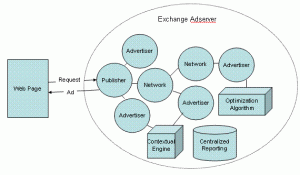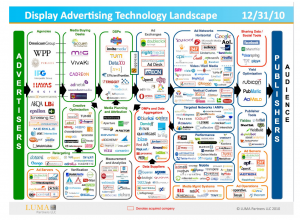The New Display Ecosystem — Part I: A few words on HYPE.
July 17th, 2011
It’s been four years since I wrote one of my most popular series of blog posts of all time — “The Ad Exchange Model”. Since then a lot has happened. A whole slew of three letter acronyms has appeared: DSP, SSP, DSP, RTB… Venture capital investments have exploded, we have multiple blogs dedicated to ad-exchanges and it looks like the space has gotten a lot more complicated.
Or put another way… in 2007 I described the world with a simple diagram. Today Terry Kawaja has an industry “LUMAscape” that has logos so small I can’t even read them.
Wow. What the hell happened? We used to have this easy world… publishers sold to advertisers, there was one exchange and then a lot of ad-networks with different pitches. How the hell did we get from there to the above hodge podge “ecosystem” that nobody understands. To help bring some clarity to this world I’d like to kick off a new series… “The RTB Display Ecosystem”. This first post is will primarily be musings on hype… as before we can talk about what’s really happening we all need to step back for a second and realize 90% of what we read is… well… bullshit. I’m sure by now you’ve seen the below diagram. It’s confusing, cluttered and supposed to explain to the world how the new Display ecosystem works. 100s of companies have incorporated this slide in their presentation. I haven’t gone to a single conference where this hasn’t come up multiple times.


How VCs and Bankers brought hype to the industry
Here’s the hard truth people don’t like to hear. The display world is actually not that complicated. Yes the ecosystem has evolved. Exchanges are core tenets of display and there certainly has been a ton of innovation in the data space. But that doesn’t make for 20 boxes on a slide. What really happened is that online advertising captured the attention of silicon valley… complete with a massive influx of VCs, $, TechCrunch posts and of course… HYPE.
You see, Venture Capitalists make money off of home runs. The top companies in a category get great exits, and after that valuations drop off very quickly. To actually be able to justify an investment a VC has to be convinced that the company has a chance at being top in it’s category. Well, this is quite hard to do if the world were simply advertisers, publishers and ad-exchanges. So what do you do? Well… you create a new category, pump millions of dollars in a company marketed as such category, and then hype up this category on TechCrunch as the next greatest thing and rejoice.
Of course VC’s have coffee with each other, hype up their investments to their VC friends (ever heard of an “Echo Chamber”?), and now they’re all clamoring to invest money in other companies who could vie to be a winner in the category and a new slew of companies gets funded.
In 2006 it was impossible to differentiate yourself as an ad-network… and thus every ad-network rebranded as an exchange. In 2007/2008 nobody could raise money as an “ad exchange” that would compete head-to-head with Google and Yahoo. But “SSP” worked out quite well… even though it’s exactly the same business model (queue funding for Rubicon, Admeld & PubMatic, etc.). In 2007/2008 you also couldn’t raise money as an ad-network, but there were plenty of companies interested in helping advertisers spend their money… enter the “DSP” category (queue funding for MediaMath, Turn, Invite Media, etc.). What’s funny is that TMP was doing the SSP business before anybody else and Ad.com has been offering “DSP Services” since .. well, forever!
VCs are also obsessed with investing in “Technology Companies” that build “Scalable Platforms”. You see, Technology is supposed to be sticky. Platforms have ecosystem effects and become $1b companies. To adapt, companies have quickly adjusted their positioning to better reflect attributes that will attract high valuations from said Venture Capitalists. Again, ad-network isn’t sexy, but a technology “Demand Side Platform” is. The funny thing is… it’s hype yet again. Most companies on the LUMAscape slide receive the majority (if not all) of their revenue from media services and not technology fees. Now this line is blurring (more on that later) but what companies are doing is saying they are “technology providers” while behind the scenes they operate exactly like a media company. An “SSP” technology provider hands out tags to publishers and then pays them a check at the end of the month together with a nice excel sheet. This is exactly the same business model of many an ad-network.
Don’t get me wrong — I’m not saying that any of the aforementioned companies aren’t or can’t be great companies. Many of the companies I mention have built terrific technologies and great businesses and some have followed that up with successful exists. But, they did all capitalize on a great marketing opportunity, at the expense of some “old world” companies who were too slow to react.
And this is where VCs and Bankers are actually hurting the industry rather than helping. They are reinforcing the importance of new categories that in themselves shouldn’t necessarily exist. Rather than focusing truly on what a company does they repeat and hence validate what companies say they do.
So what’s next?
Well first, let’s stop the hype cycle and start celebrating real successful businesses for what they have accomplished. Give me more case studies of real results and less BS!
In the coming blog posts I’m going to lay out the new RTB ecosystem and how all the different parties are interacting. Your feedback is as always invaluable so please leave comments with specific topics you’d love covered.
It’s time to drive for simpler integration
August 2nd, 2007
So take this scenario. Your company just signed a huge deal with Avenue-A. You’ve just gotten a million dollars to spend for the quarter, it’s the big break you’ve been waiting for! You send your ops guy Marvin to coordinate the details with Avenue-A’s people and open a bottle of bubbly to celebrate. A week later you pull some reports and realize that you haven’t run a single impression yet. You yell out —
”MAARVVIIIIIIIIIIIIN!!!!!”.
”Yes sir?”
”Why the hell isn’t the Avenue-A deal running?”
”Oh, we couldn’t get click-tracking to work yet. I’ve got a ticket into support.”
Sound familiar? How about trying to get behavioral pixels live on a publisher’s page? Enabling age & gender passing on ad-calls for custom optimization? These mundane seemingly simple tasks can take weeks. Why? normal people using complex technical products.
Read this quote from the MSN Games 300×250 ad standards:
(A) Click-through tracking is not available on the following advertising elements:
• HTML advertising elements that use method=”POST” for form submittal.
• Rich media elements that use embedded or compiled URL information (Macromedia Flash creatives that do not use the FS command, for example).
• Third party served HTML (IFrame) campaigns.
(B) Cache-busting is available automatically for pre-approved third party served agencies, others by request only. Exception: Third party served click URLs for hard-coded placements (text links, etc.) are not cache busted. Therefore, MSN click data for hard-coded placements using third party served click URLs may not match click data from the third party agency. Please enter the Cache busting tags; MSN is not responsible for entering these tags.
I can’t be the only one that thinks that this is absolutely ridiculous. How can it possibly take five days to get an ad live? This is a process that should take mere hours! Why should people know the difference between method=”GET” and “POST”? Your average media-buyer probably has a degree in English, your ad-ops guy? History? Philosophy? It shouldn’t be the least bit surprising that these people have so much trouble doing what those of us with technical knowledge may find simple.
By nature what we do is technical, it is called online advertising! Purely from a technical perspective we cant buy or sell inventory without snippets of HTML that enable communication and highly complex adservers to do decisioning and optimization. What makes matters worse is that most ad-impressions involve two adservers, if not many more. The way things work today, these systems can’t talk to each-other directly and all communication must pass through the browser, which only reads HTML, XML, Javascript, Java, etc… more technical things!
Yet, just because adservers can’t communicate without HTML, Javascript and redirects doesn’t mean that users should have to worry about these details. Come on! Think of WordPress or Blogger, both services that have brought web-publishing to the masses. They have abstracted almost all technical aspects of blogging allowing anybody to post their thoughts online — why can’t we do the same in our products? I’m not sure I have a solution right this second, but perhaps we should begin by re-examining what is considered “normal” today. Here’s my list:
- Knowledge of HTML is needed to enable clicktracking/li>
- 5 days is considered normal and acceptable turnaround time for trafficking third party ads
- Passing user data between systems involves knowledge of querystrings
- Adservers have vastly different standards, heck, users need to know whether to encode or not
- None of the above can be implemented without a “test” to confirm it really works
Most of the above stem from the fact that we have many different platforms, a situation that is unlikely to change in the foreseeable future. Sure, if both the advertiser and the publisher are using one system things are easy — DART has internal redirects, Right Media has linking and I’m sure others have or will invent similar concepts. The problem is, there will always be advertisers and publishers that will work with all three systems — which the way things look today means more redirects, click-tracking and long delays to activate campaigns or setup tags.
So product managers, architects and engineers, I think it’s time to put on your thinking caps to figure out how systems can better work together to make the day to day lives of the people who actually use said systems much easier. A million dollar Avenue-A deal should never hinge on a trafficker editing the HTML of the ad-tags to enable click-tracking.





